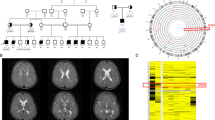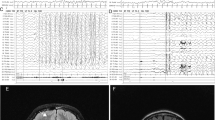Abstract
Alternating hemiplegia of childhood (AHC) is a rare neurodevelopment disorder that is typically characterized by debilitating episodic attacks of hemiplegia, seizures, and intellectual disability. Over 85% of individuals with AHC have a de novo missense variant in ATP1A3 encoding the catalytic α3 subunit of neuronal Na+/K+ ATPases. The remainder of the patients are genetically unexplained. Here, we used next-generation sequencing to search for the genetic cause of 26 ATP1A3-negative index patients with a clinical presentation of AHC or an AHC-like phenotype. Three patients had affected siblings. Using targeted sequencing of exonic, intronic, and flanking regions of ATP1A3 in 22 of the 26 index patients, we found no ultra-rare variants. Using exome sequencing, we identified the likely genetic diagnosis in 9 probands (35%) in five genes, including RHOBTB2 (n = 3), ATP1A2 (n = 3), ANK3 (n = 1), SCN2A (n = 1), and CHD2 (n = 1). In follow-up investigations, two additional ATP1A3-negative individuals were found to have rare missense SCN2A variants, including one de novo likely pathogenic variant and one likely pathogenic variant for which inheritance could not be determined. Functional evaluation of the variants identified in SCN2A and ATP1A2 supports the pathogenicity of the identified variants. Our data show that genetic variants in various neurodevelopmental genes, including SCN2A, lead to AHC or AHC-like presentation. Still, the majority of ATP1A3-negative AHC or AHC-like patients remain unexplained, suggesting that other mutational mechanisms may account for the phenotype or that cases may be explained by oligo- or polygenic risk factors.
This is a preview of subscription content, access via your institution
Access options
Subscribe to this journal
Receive 12 print issues and online access
$259.00 per year
only $21.58 per issue
Buy this article
- Purchase on SpringerLink
- Instant access to full article PDF
Prices may be subject to local taxes which are calculated during checkout



Similar content being viewed by others
Data availability
The individuals did not consent to controlled release of the data into dbGAP or SRA, however, the raw data analyzed in this study are available from the corresponding author on reasonable request.
References
Verret S, Steele JC. Alternating hemiplegia in childhood: a report of eight patients with complicated migraine beginning in infancy. Pediatrics. 1971;47:675–80.
Bourgeois M, Aicardi J, Goutieres F. Alternating hemiplegia of childhood. J Pediatr. 1993;122:673–9.
Mikati MA, Kramer U, Zupanc ML, Shanahan RJ. Alternating hemiplegia of childhood: clinical manifestations and long-term outcome. Pediatr Neurol. 2000;23:134–41.
Sweney MT, Silver K, Gerard-Blanluet M, Pedespan JM, Renault F, Arzimanoglou A, et al. Alternating hemiplegia of childhood: early characteristics and evolution of a neurodevelopmental syndrome. Pediatrics. 2009;123:e534–41.
Panagiotakaki E, Doummar D, Nogue E, Nagot N, Lesca G, Riant F, et al. Movement disorders in patients with alternating hemiplegia: “Soft” and “stiff” at the same time. Neurology. 2020;94:e1378–85.
Heinzen EL, Swoboda KJ, Hitomi Y, Gurrieri F, Nicole S, de Vries B, et al. De novo mutations in ATP1A3 cause alternating hemiplegia of childhood. Nat Genet. 2012;44:1030–4.
Rosewich H, Thiele H, Ohlenbusch A, Maschke U, Altmuller J, Frommolt P, et al. Heterozygous de-novo mutations in ATP1A3 in patients with alternating hemiplegia of childhood: a whole-exome sequencing gene-identification study. Lancet Neurol. 2012;11:764–73.
Swoboda KJ, Kanavakis E, Xaidara A, Johnson JE, Leppert MF, Schlesinger-Massart MB, et al. Alternating hemiplegia of childhood or familial hemiplegic migraine? A novel ATP1A2 mutation. Ann Neurol. 2004;55:884–7.
Huang D, Liu M, Wang H, Zhang B, Zhao D, Ling W, et al. De novo ATP1A2 variants in two Chinese children with alternating hemiplegia of childhood upgraded the gene-disease relationship and variant classification: a case report. BMC Med Genom. 2021;14:95.
Defo A, Verloes A, Elenga N. Developmental and epileptic encephalopathy related to a heterozygous variant of the RHOBTB2 gene: A case report from French Guiana. Mol Genet Genom Med. 2022;10:e1929.
Zagaglia S, Steel D, Krithika S, Hernandez-Hernandez L, Custodio HM, Gorman KM, et al. RHOBTB2 mutations expand the phenotypic spectrum of alternating hemiplegia of childhood. Neurology. 2021;96:e1539–50.
DePristo MA, Banks E, Poplin R, Garimella KV, Maguire JR, Hartl C, et al. A framework for variation discovery and genotyping using next-generation DNA sequencing data. Nat Genet. 2011;43:491–8.
Cingolani P, Platts A, Wang le L, Coon M, Nguyen T, Wang L, et al. A program for annotating and predicting the effects of single nucleotide polymorphisms, SnpEff: SNPs in the genome of Drosophila melanogaster strain w1118; iso-2; iso-3. Fly. 2012;6:80–92.
Ren A, Zhang D, Tian Y, Cai P, Zhang T, Hu QN. Transcriptor: a comprehensive platform for annotation of the enzymatic functions of transcripts. Bioinformatics. 2021;37:434–5.
Richards S, Aziz N, Bale S, Bick D, Das S, Gastier-Foster J, et al. Standards and guidelines for the interpretation of sequence variants: a joint consensus recommendation of the American College of Medical Genetics and Genomics and the Association for Molecular Pathology. Genet Med. 2015;17:405–24.
Castro MJ, Nunes B, de Vries B, Lemos C, Vanmolkot KR, van den Heuvel JJ, et al. Two novel functional mutations in the Na+,K+-ATPase alpha2-subunit ATP1A2 gene in patients with familial hemiplegic migraine and associated neurological phenotypes. Clin Genet. 2008;73:37–43.
Pressley TA. Phylogenetic conservation of isoform-specific regions within alpha-subunit of Na(+)-K(+)-ATPase. Am J Physiol. 1992;262:C743–51.
Jiang Y, Han Y, Petrovski S, Owzar K, Goldstein DB, Allen AS. Incorporating functional information in tests of excess de novo mutational load. Am J Hum Genet. 2015;97:272–83.
Moya-Mendez ME, Mueller DM, Pratt M, Bonner M, Elliott C, Hunanyan A, et al. Early onset severe ATP1A2 epileptic encephalopathy: clinical characteristics and underlying mutations. Epilepsy Behav. 2021;116:107732.
Panagiotakaki E, Papadopoulou MT, Lesca G, Arzimanoglou A, Mikati MA. De novo mutations in CLDN5: alternating hemiplegia of childhood or not? Brain. 2023;146:e57-8.
Bassi MT, Bresolin N, Tonelli A, Nazos K, Crippa F, Baschirotto C, et al. A novel mutation in the ATP1A2 gene causes alternating hemiplegia of childhood. J Med Genet. 2004;41:621–8.
De Fusco M, Marconi R, Silvestri L, Atorino L, Rampoldi L, Morgante L, et al. Haploinsufficiency of ATP1A2 encoding the Na+/K+ pump alpha2 subunit associated with familial hemiplegic migraine type 2. Nat Genet. 2003;33:192–6.
Pietrobon D. Familial hemiplegic migraine. Neurotherapeutics. 2007;4:274–84.
de Vries B, Stam AH, Beker F, van den Maagdenberg AM, Vanmolkot KR, Laan L, et al. CACNA1A mutation linking hemiplegic migraine and alternating hemiplegia of childhood. Cephalalgia. 2008;28:887–91.
Mikati MA, Panagiotakaki E, Arzimanoglou A. Revision of the diagnostic criteria of alternating hemiplegia of childhood. Eur J Paediatr Neurol. 2021;32:A4–A5.
Ogiwara I, Ito K, Sawaishi Y, Osaka H, Mazaki E, Inoue I, et al. De novo mutations of voltage-gated sodium channel alphaII gene SCN2A in intractable epilepsies. Neurology. 2009;73:1046–53.
Wolff M, Johannesen KM, Hedrich UBS, Masnada S, Rubboli G, Gardella E, et al. Genetic and phenotypic heterogeneity suggest therapeutic implications in SCN2A-related disorders. Brain. 2017;140:1316–36.
Mikati MA, Maguire H, Barlow CF, Ozelius L, Breakefield XO, Klauck SM, et al. A syndrome of autosomal dominant alternating hemiplegia: clinical presentation mimicking intractable epilepsy; chromosomal studies; and physiologic investigations. Neurology. 1992;42:2251–7.
Rosewich H, Ohlenbusch A, Huppke P, Schlotawa L, Baethmann M, Carrilho I, et al. The expanding clinical and genetic spectrum of ATP1A3-related disorders. Neurology. 2014;82:945–55.
Rui H, Artigas P, Roux B. The selectivity of the Na(+)/K(+)-pump is controlled by binding site protonation and self-correcting occlusion. Elife. 2016;5:e16616.
Acknowledgements
We greatly acknowledge the subjects who participated in this study. We also thank Jean-Marc DeKeyser and Tatiana Abramova for generating and expressing the SCN2A variants. Moreover, we thank Geert van Weelden and Jeroen van den Heuvel for their help with the functional analysis of the ATP1A2 variants.
Funding
Genetic studies were funded in part by a grant from Cure AHC (ELH), AFM-Telethon, and AFHA (SN). Functional studies of SCN2A were supported by NIH grant NS108874 (ALG). The variant analysis of SCN2A Italian patients was supported by AISEA (FG, FDT).
Author information
Authors and Affiliations
Consortia
Contributions
EP, FDT, MAM, FG, AMJMvdM and ELH conceived and designed the study. EP, FDT, MAM, AVEH, LSV, FG, AMJMvdM and ELH drafted or revised the manuscript. EP, FDT, MAM, LSV, SN, AVEH, NMW, FG, AMJMvdM, and ELH generated and interpreted sequence data. CHT, ALG and JK generated and interpreted the functional data. EP, MAM, SN, GL, EA, AN, LDP, NMW, EDG, ALP, VDP, AL, MCN, AA and RV provided patient samples, phenoptyic data, and interpreted interpreted genotype-phenotype correlations. All authors reviewed and approved the final version and agreed to be accountable for all aspects or the work.
Corresponding authors
Ethics declarations
Competing interests
ALG serves on a scientific advisory board for Tevard Biosciences, and consults for Praxis Precision Medicines. ALG receives grant funding from Tevard Biosciences, Praxis Precision Medicines, and Neurocrine Biosciences for unrelated work. AMJMvdM received funding from Schedule 1 Therapeutics and Praxis Precision Medicines for unrelated work. The other authors declare no conflicts of interest.
Ethical approval
All subjects were consented to participate in this research study through protocols approved by local ethics boards.
Additional information
Publisher’s note Springer Nature remains neutral with regard to jurisdictional claims in published maps and institutional affiliations.
Supplementary information
Rights and permissions
Springer Nature or its licensor (e.g. a society or other partner) holds exclusive rights to this article under a publishing agreement with the author(s) or other rightsholder(s); author self-archiving of the accepted manuscript version of this article is solely governed by the terms of such publishing agreement and applicable law.
About this article
Cite this article
Panagiotakaki, E., Tiziano, F.D., Mikati, M.A. et al. Exome sequencing of ATP1A3-negative cases of alternating hemiplegia of childhood reveals SCN2A as a novel causative gene. Eur J Hum Genet 32, 224–231 (2024). https://doi.org/10.1038/s41431-023-01489-4
Received:
Revised:
Accepted:
Published:
Issue Date:
DOI: https://doi.org/10.1038/s41431-023-01489-4



